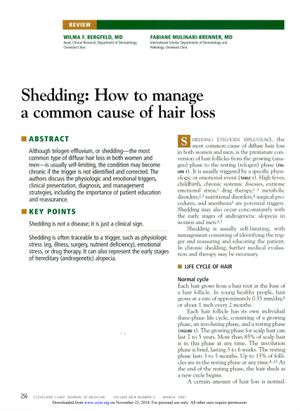Shedding: How to manage a common cause of hair loss
March 2001
in “
Cleveland Clinic Journal of Medicine
”

TLDR Manage hair shedding by identifying triggers, possibly using supplements or medications, and tracking with a health calendar.
The 2001 document outlines the management of telogen effluvium, a common form of hair loss due to the premature transition of hair follicles to the resting phase, often caused by stress, illness, nutrient deficiencies, or medications. It highlights the importance of educating patients, identifying and managing triggers, and reassurance that shedding does not lead to baldness. Acute shedding may resolve without treatment, while chronic shedding might require interventions such as nutrient supplementation or minoxidil. A "health calendar" is suggested for tracking shedding and triggers. For severe or chronic cases, treatments like corticosteroids (10-20 mg/day of prednisone) or antiandrogens (spironolactone at 100-300 mg/day or flutamide at 250-500 mg/day) combined with birth control pills can be effective, especially in women with androgen excess, with potential improvement seen within 8 weeks. Monitoring patients for new triggers is crucial.





